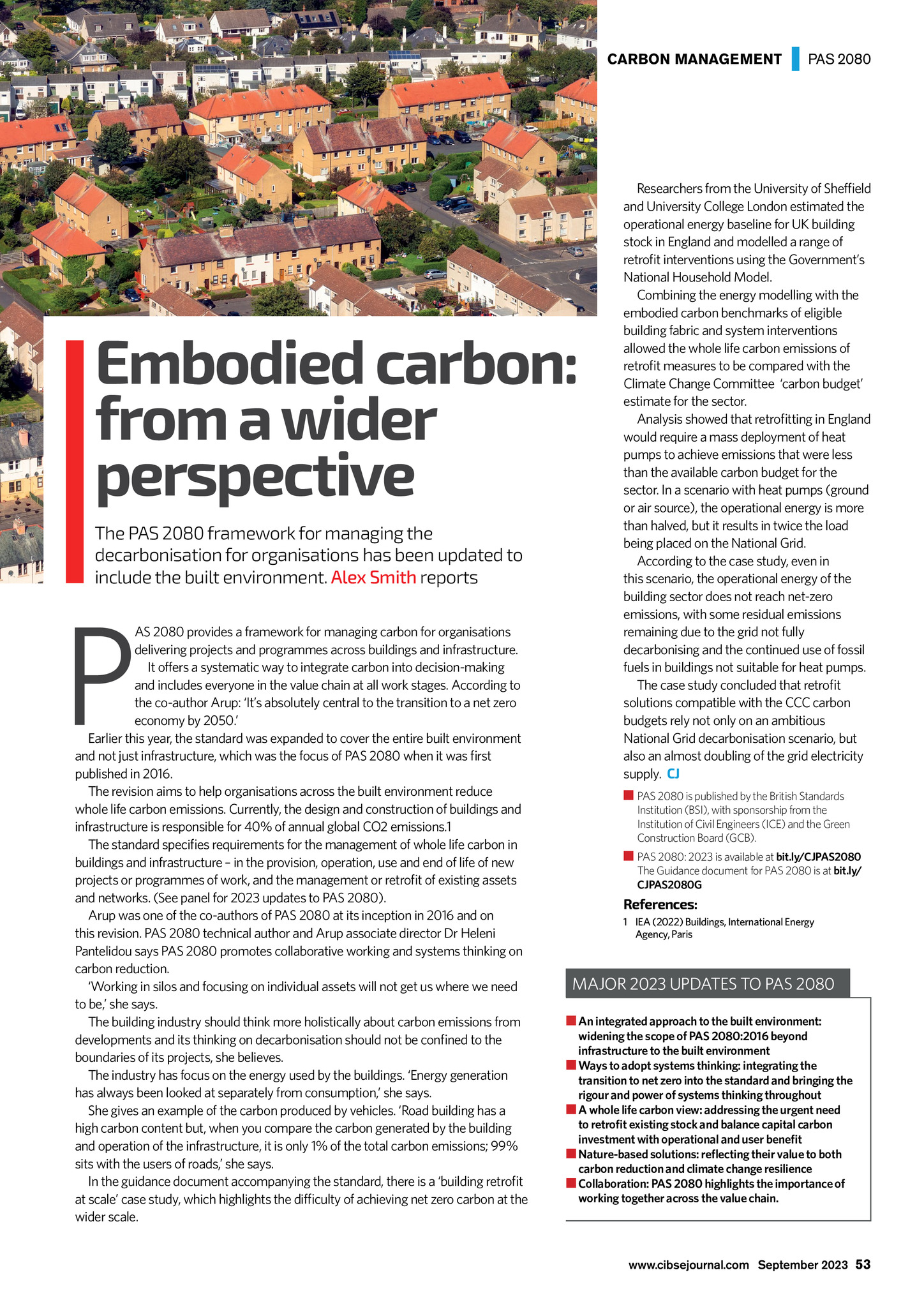


CARBON MANAGEMENT Embodied carbon: from a wider perspective The PAS 2080 framework for managing the decarbonisation for organisations has been updated to include the built environment. Alex Smith reports P AS 2080 provides a framework for managing carbon for organisations delivering projects and programmes across buildings and infrastructure. It offers a systematic way to integrate carbon into decision-making and includes everyone in the value chain at all work stages. According to the co-author Arup: Its absolutely central to the transition to a net zero economy by 2050. Earlier this year, the standard was expanded to cover the entire built environment and not just infrastructure, which was the focus of PAS 2080 when it was first published in 2016. The revision aims to help organisations across the built environment reduce whole life carbon emissions. Currently, the design and construction of buildings and infrastructure is responsible for 40% of annual global CO2 emissions.1 The standard specifies requirements for the management of whole life carbon in buildings and infrastructure in the provision, operation, use and end of life of new projects or programmes of work, and the management or retrofit of existing assets and networks. (See panel for 2023 updates to PAS 2080). Arup was one of the co-authors of PAS 2080 at its inception in 2016 and on this revision. PAS 2080 technical author and Arup associate director Dr Heleni Pantelidou says PAS 2080 promotes collaborative working and systems thinking on carbon reduction. Working in silos and focusing on individual assets will not get us where we need to be, she says. The building industry should think more holistically about carbon emissions from developments and its thinking on decarbonisation should not be confined to the boundaries of its projects, she believes. The industry has focus on the energy used by the buildings. Energy generation has always been looked at separately from consumption, she says. She gives an example of the carbon produced by vehicles. Road building has a high carbon content but, when you compare the carbon generated by the building and operation of the infrastructure, it is only 1% of the total carbon emissions; 99% sits with the users of roads, she says. In the guidance document accompanying the standard, there is a building retrofit at scale case study, which highlights the difficulty of achieving net zero carbon at the wider scale. | PAS 2080 Researchers from the University of Sheffield and University College London estimated the operational energy baseline for UK building stock in England and modelled a range of retrofit interventions using the Governments National Household Model. Combining the energy modelling with the embodied carbon benchmarks of eligible building fabric and system interventions allowed the whole life carbon emissions of retrofit measures to be compared with the Climate Change Committee carbon budget estimate for the sector. Analysis showed that retrofitting in England would require a mass deployment of heat pumps to achieve emissions that were less than the available carbon budget for the sector. In a scenario with heat pumps (ground or air source), the operational energy is more than halved, but it results in twice the load being placed on the National Grid. According to the case study, even in this scenario, the operational energy of the building sector does not reach net-zero emissions, with some residual emissions remaining due to the grid not fully decarbonising and the continued use of fossil fuels in buildings not suitable for heat pumps. The case study concluded that retrofit solutions compatible with the CCC carbon budgets rely not only on an ambitious National Grid decarbonisation scenario, but also an almost doubling of the grid electricity supply. CJ P AS 2080 is published by the British Standards Institution (BSI), with sponsorship from the Institution of Civil Engineers (ICE) and the Green Construction Board (GCB). PAS 2080: 2023 is available at bit.ly/CJPAS2080 The Guidance document for PAS 2080 is at bit.ly/ CJPAS2080G References: 1 IEA (2022) Buildings, International Energy Agency, Paris MAJOR 2023 UPDATES TO PAS 2080 An integrated approach to the built environment: widening the scope of PAS 2080:2016 beyond infrastructure to the built environment Ways to adopt systems thinking: integrating the transition to net zero into the standard and bringing the rigour and power of systems thinking throughout A whole life carbon view: addressing the urgent need to retrofit existing stock and balance capital carbon investment with operational and user benefit Nature-based solutions: reflecting their value to both carbon reduction and climate change resilience Collaboration: PAS 2080 highlights the importance of working together across the value chain. www.cibsejournal.com September 2023 53